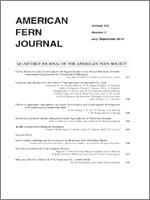Mycorrhizal fungi form dynamic symbiotic association in the roots of about 80% of the total terrestrial vascular land plants. Among the pteridophytes, mycorrhizal associations are more frequent in the gametophytes than in the sporophytes. Gametophytes of many ferns and lycophytes exhibit obligate mycotrophy. Despite several benefits derived from the mycorrhizal fungi, very little work has been done surveying the distribution and diversity of arbuscular mychorrhizal (AM) fungi in pteridophytes. We intensified our studies in the roots of sporophytes of Christella dentata (Forssk.) Brownsey & Jermy (Thelypteridaceae) to understand the distribution of AM fungi in different parts of the main adventitious root and its lateral branches, along with percent root colonization. We also evaluated spore density of AM fungi in the soil and seasonal variations in the hyphal colonization and formation of vesicles and arbuscules. Root colonization was present in the lateral roots only and not on the main adventitious roots. Percent root colonization also varied in different parts of the lateral roots. The results indicated that root colonization percentage of AM mycorrhizal fungi varies not only by the growth stages of host plants but also by season. Soil spore count was highest in the winter and lowest during the rainy season. In addition to AM fungi, another type of root colonizing fungi, dark septate fungi (DSF) or dark septate endophytes (DSE), has also been recorded in the roots of C. dentata. Dark septate fungi with melanized hyphae and microsclerotia were documented.
BioOne.org will be down briefly for maintenance on 17 December 2024 between 18:00-22:00 Pacific Time US. We apologize for any inconvenience.
How to translate text using browser tools
1 July 2012
Occurrence of Dark Septate Endophytes in the Sporophytes of Christella dentata
Rebeca Ghanta,
Sikha Dutta,
Radhanath Mukhopadhyay
ACCESS THE FULL ARTICLE

American Fern Journal
Vol. 102 • No. 3
July 2012
Vol. 102 • No. 3
July 2012
arbuscular mycorrhizae
Christella dentata
Dark septate fungus
Glomus sp




